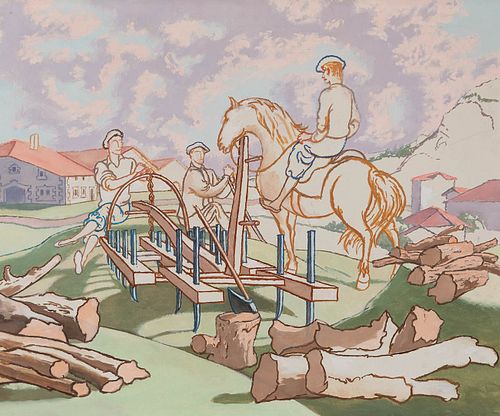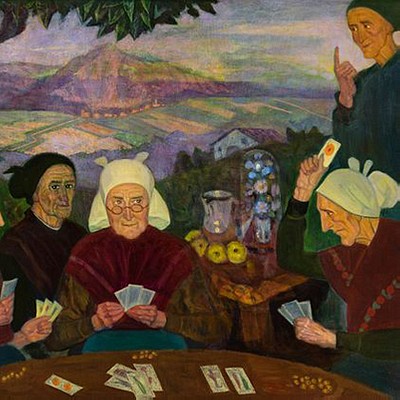JOSE MARIA UCELAY (Bermeo, Biscay, 1903- Bilbao, 1979). "Basque costumbrista scene", ca. 1976. Oil on canvas.
Lot 82
About Seller
Setdart Auction House
Carrer Aragó 346
Barcelona
Spain
Setdart Subastas was born in 2004 and is currently the first online art auction in Spain with solidity, prestige and reliability guaranteed by our more than 60,000 users. Setdart has a young, dynamic and enterprising team ready to successfully manage the purchase and sale of art works through custom...Read more
Estimate:
EUR€15,000 - EUR€18,000
$15,625 - $18,750
Absentee vs Live bid
Two ways to bid:
- Leave a max absentee bid and the platform will bid on your behalf up to your maximum bid during the live auction.
- Bid live during the auction and your bids will be submitted real-time to the auctioneer.
Bid Increments
| Price | Bid Increment |
|---|---|
| EUR€0 | EUR€10 |
| EUR€200 | EUR€25 |
| EUR€500 | EUR€50 |
| EUR€1,000 | EUR€100 |
| EUR€3,000 | EUR€200 |
| EUR€5,000 | EUR€500 |
| EUR€10,000 | EUR€1,000 |
| EUR€20,000 | EUR€2,000 |
| EUR€50,000 | EUR€5,000 |
About Auction
By Setdart Auction House
Dec 14, 2021
Set Reminder
2021-12-14 08:00:00
2021-12-14 08:00:00
America/New_York
Bidsquare
Bidsquare : 19th & 20th Century Fine Art
https://www.bidsquare.com/auctions/setdart-auction-house/19th-20th-century-fine-art-7992
Gaudi, Sorolla, Torres Garcia, Maclet, TSUGUHARU FOUJITA, Benjamin Palencia Setdart Auction House sofia@setdart.com
Gaudi, Sorolla, Torres Garcia, Maclet, TSUGUHARU FOUJITA, Benjamin Palencia Setdart Auction House sofia@setdart.com
- Lot Description
JOSE MARIA UCELAY (Bermeo, Biscay, 1903- Bilbao, 1979). "Basque costumbrista scene", ca. 1976. Oil on canvas. Provenance: Formerly collection of the artist's widow. Work reproduced in black and white in "Uzelai. Ucelay", Kosme Mª de Barañano Letamendia, page 199, n. 369. Measurements: 60 x 72 cm; 73 x 86 cm (frame). Jose Maria Ucelay's role in the art world was not limited to painting, but he also developed a great work to evacuate part of the Basque artistic heritage before the advance of Franco's troops. Ucelay's work is distinguished by its marked personal style, being considered the most original of the so-called "Basque School". His characters, inscribed in realism, somewhat mannerist due to the elongation of its forms, are refined; its colors, attenuated, in a harmonious palette of calm tones. The fantastic canvas we are dealing with represents three Basque villagers, one of them on horseback, surrounded by farming tools and large logs of cut firewood. The scene takes place in a vast Basque landscape, dotted with farmhouses and ultimately high mountains. When he was only 19 years old, the Bilbao Fine Arts Museum acquired his first work: "A Girl", an impulse that led Ucelay to move to Madrid and study at the Royal Academy of Fine Arts of San Fernando. In the Spanish capital, the Basque artist met important figures of the artistic scene of the time: Salvador Dalí, Luis Buñuel, Rafael Alberti or Federico García Lorca, among others. Some time later he traveled to Paris, where he met other artists, as well as the writer Ernest Hemingway. During those years, he participated in a large number of exhibitions in different European and American cities, such as the inaugural exhibition of the Museum of Modern Art in Bilbao in 1924, an important event for the development of Basque art. In 1936, Ucelay was appointed Director General of Fine Arts, Archives and Libraries within the Department of Justice and Culture of the Basque Country. His task consisted of safeguarding works of art together with the painters Julián de Tellaeche and Mauricio Flores Kaperotxipi. The heritage that was withdrawn was kept in different deposits that were established in the capital. The Museum of Fine Arts and the Museum of Modern Art of Bilbao were moved there, as well as other public and private collections. Ucelay is currently represented in important state collections, such as the Reina Sofía Museum and the Bilbao Fine Arts Museum.
- Shipping Info
-
In-house shipping available. Please inquire at admin@setdart.com.
-
- Buyer's Premium



 EUR
EUR CAD
CAD AUD
AUD GBP
GBP MXN
MXN HKD
HKD CNY
CNY MYR
MYR SEK
SEK SGD
SGD CHF
CHF THB
THB














